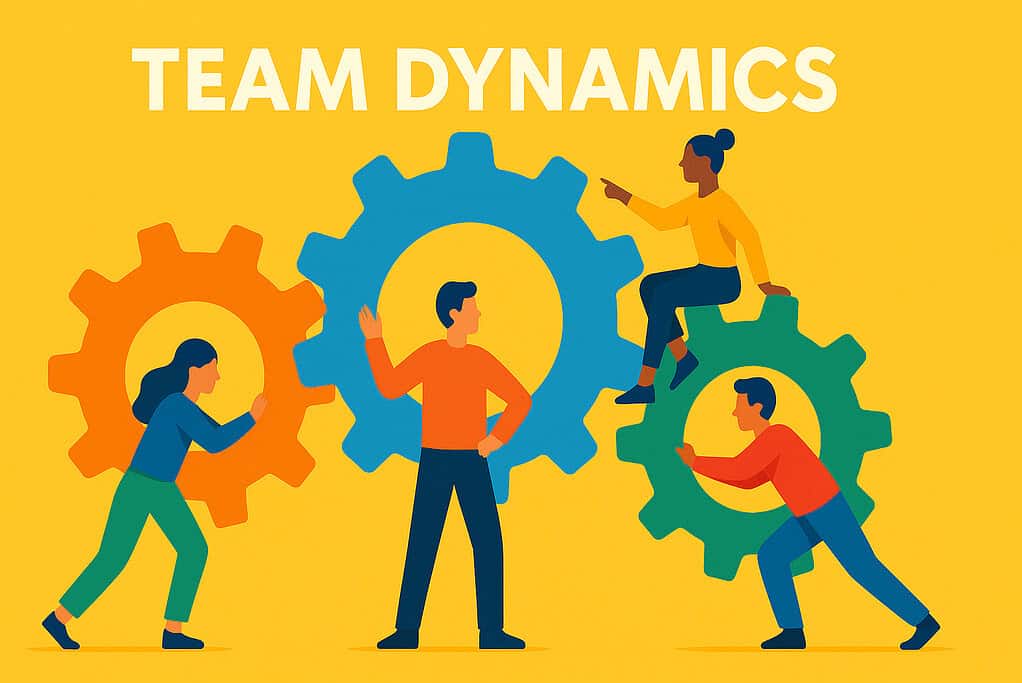Table of Contents
Introduction – Team Dynamics: The Hidden Force Behind Shared Business Stories
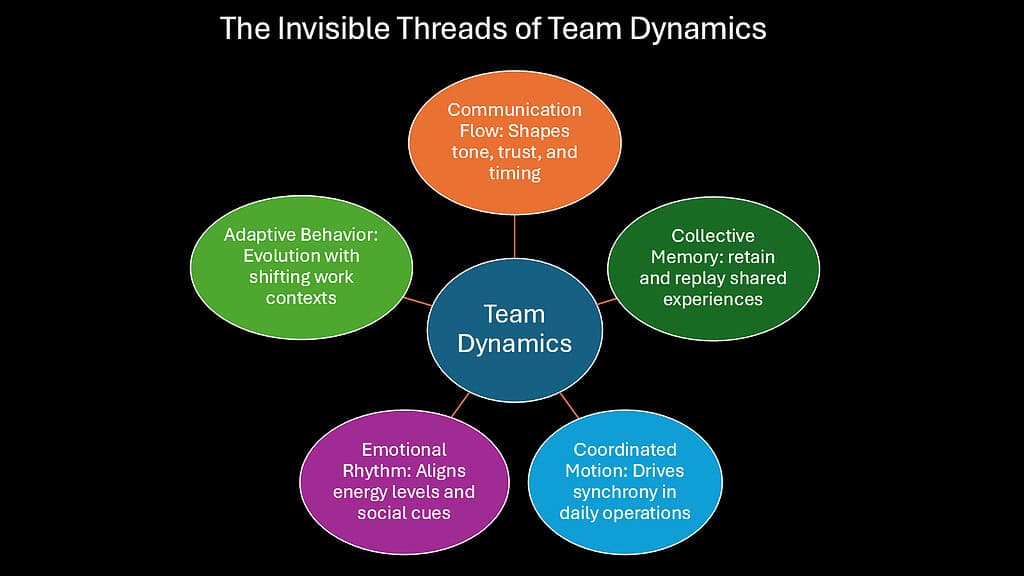
In the bustling conference rooms and digital workspaces where modern business unfolds, something invisible yet powerful shapes organizational success. Team dynamics—the subtle interactions, relationships, and communication patterns between team members—quietly influence everything from daily operations to long-term strategic direction. These dynamics aren’t merely about how well people get along; they’re the fertile soil where shared narratives take root, grow, and eventually define organizational identity.
Organizations increasingly recognize that their most valuable asset isn’t their intellectual property or market share—it’s the collective story their teams create together. When McKinsey surveyed over 5,000 executives about factors driving organizational performance, they found that teams with healthy dynamics were 1.3 times more likely to outperform industry peers financially. Yet the connection between team dynamics and narrative-building remains underexplored territory.
“Teams with strong dynamics don’t just work better—they remember better,” notes Amy Edmondson of Harvard Business School, whose research on psychological safety underscores how team environments shape collective memory and meaning-making. “They create stories that endure beyond quarterly results or annual strategies.”
This narrative-building function transcends departments and industries. Whether in product development at tech startups or patient care teams in healthcare, the way team members interact creates an ongoing story about who they are and what they stand for. These stories become the unofficial history of the organization—remembered long after spreadsheets are archived and presentations forgotten.
| Aspect of Team Dynamics | Impact on Narrative Formation | Organizational Benefit |
|---|---|---|
| Psychological Safety | Encourages authentic sharing of experiences | Richer, more nuanced organizational stories |
| Communication Patterns | Shapes how victories and setbacks are discussed | More coherent collective memory |
| Role Clarity | Defines character arcs within team story | Clearer sense of purpose and contribution |
| Conflict Resolution | Determines how challenges become part of the narrative | Resilience and adaptability as core story elements |
| Celebration Rituals | Marks milestone moments that anchor the narrative | Stronger emotional connection to shared history |
This article explores six specific ways that team dynamics function as narrative engines in organizations. From sensemaking in rapidly changing environments to transforming setbacks into defining moments, we’ll examine how the quiet force of team dynamics builds stories that outlast individual projects and even team membership itself. These shared narratives ultimately become the organization’s most enduring asset—its collective memory and identity.
1. Team Dynamics and Shared Sensemaking in Fast-Moving Workspaces
When markets shift overnight or industry disruptions arrive without warning, organizations face a fundamental challenge beyond strategy adjustment—they must make sense of what’s happening collectively. This is where team dynamics prove indispensable. Teams with strong dynamics don’t just respond faster; they construct shared interpretations that help everyone navigate uncertainty together.
Karl Weick’s Sensemaking Theory provides a valuable framework for understanding this process. Weick, an organizational psychologist, describes sensemaking as the ongoing process through which people create order and make retrospective sense of what occurs. Within teams, this isn’t an individual cognitive process but a collective one, heavily influenced by how team members interact with each other.
“In high-velocity environments, traditional planning becomes less relevant than collective meaning-making,” explains Kathleen Sutcliffe, whose work with Weick has expanded sensemaking theory. “Teams that excel at this don’t just share information—they co-create understanding.”
This plays out visibly during crisis moments. When Starbucks faced backlash over a racial bias incident in 2018, the executive team’s dynamics influenced how they collectively interpreted the situation. Their shared sensemaking process led to closing 8,000 stores for racial bias training—a decision that reflected a narrative about organizational values and identity.
Similarly, healthcare teams dealing with unexpected patient complications engage in rapid sensemaking. Research from Johns Hopkins Medicine shows that teams with established trust patterns develop more coherent explanations for unexpected outcomes and learn more effectively from them, embedding these experiences into their ongoing story of professional growth.
| Element of Sensemaking | How Team Dynamics Shape It | Narrative Outcome |
|---|---|---|
| Noticing | Strong dynamics increase collective attention capacity | More complete story with fewer blind spots |
| Interpretation | Psychological safety allows diverse perspectives | Multi-dimensional narrative with greater depth |
| Labeling | Communication patterns affect how events are named | Shared vocabulary that frames collective memory |
| Action | Coordination quality determines response coherence | More consistent plot development |
| Retrospection | Reflection habits influence story crystallization | More intentional narrative that informs future action |
Teams with healthy dynamics don’t just make better decisions during uncertainty—they create narratives that transform confusion into clarity. The story that emerges isn’t merely about what happened but what it meant. When Southwest Airlines faced massive cancellations during the 2022 holiday season, teams with strong sensemaking capabilities didn’t just tackle operational issues; they constructed a shared narrative about organizational resilience that guided recovery efforts.
This narrative-building function of team dynamics becomes particularly valuable when organizations face ambiguous situations where there’s no playbook. The stories teams tell themselves about what’s happening, why it matters, and how they’ll move forward become the foundation for collective action—turning confusion into shared clarity that propels the organization forward.
2. Team Dynamics Fuel the Memory Loop of Small Wins and Losses
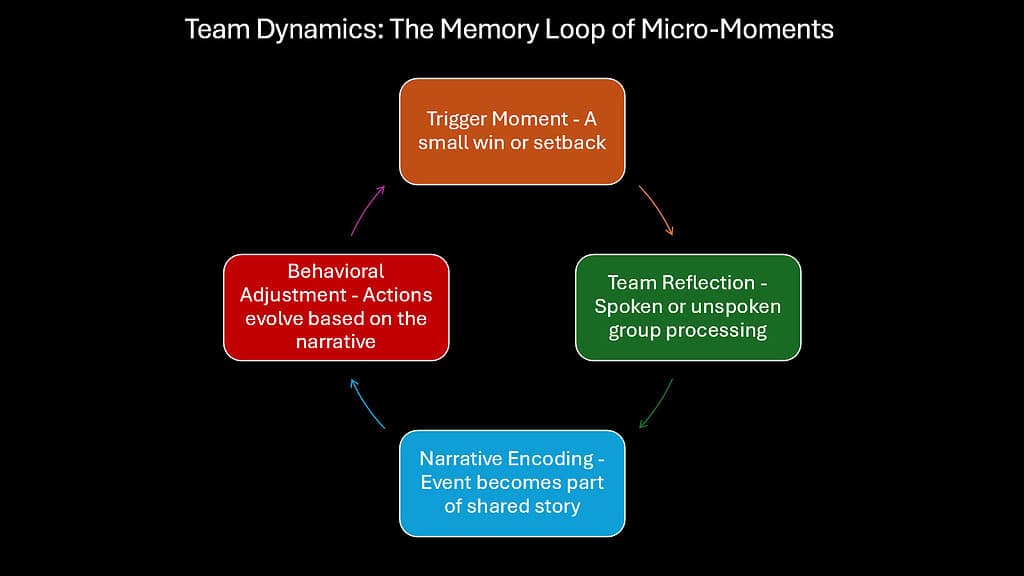
In the daily flow of organizational life, countless small moments could either fade into obscurity or become part of something larger. The difference often lies in team dynamics. Teams with healthy interaction patterns create what Stanford’s Teresa Amabile calls “the progress principle”—a virtuous cycle where even minor achievements become building blocks of an ongoing narrative.
This narrative-building function operates through what might be called the “memory loop” of teams. When a project milestone is reached, a customer problem solved, or a process improved, teams with strong dynamics don’t just acknowledge these moments—they integrate them into their shared story through specific behaviors and interactions.
“We found that teams who discussed small wins regularly were 76% more likely to maintain momentum on complex projects,” reports research from Deloitte’s Human Resources practice. “It wasn’t just about motivation—these discussions were actively constructing a narrative of capability that teams drew upon during challenges.”
This memory loop functions just as powerfully with setbacks. When a product launch underperforms or a deadline is missed, teams with healthy dynamics engage in what Harvard’s Amy Edmondson calls “productive failure conversation.” Rather than assigning blame or minimizing the issue, they collectively process what happened, extract learning, and incorporate the experience into their evolving story.
| Memory Loop Component | Team Dynamic Influence | Narrative Contribution |
|---|---|---|
| Recognition | Attention patterns determine which events get noticed | Selects which moments become part of the story |
| Discussion | Conversation norms shape how events are processed | Determines emotional tone and meaning of story elements |
| Documentation | Knowledge-sharing habits preserve experiences | Creates tangible artifacts of the team narrative |
| Reference | Communication patterns determine which memories persist | Establishes recurring themes and motifs in team story |
| Application | Learning behavior connects past to present decisions | Builds continuity and coherence across the narrative |
The Japanese principle of ‘hansei’ (reflection) illustrates this dynamic effectively. Toyota’s engineering teams engage in regular reflection sessions to assess both successes and shortcomings. This process transcends mere operations; it contributes to narrative development. These reflections integrate personal experiences into a shared narrative focused on ongoing enhancement.
Similarly, European organizations like Spotify have developed “team health checks” where dynamics are regularly assessed and adjusted. These aren’t just performance management tools but narrative maintenance mechanisms that ensure the team’s story remains coherent and progressive.
When software company Basecamp faced public criticism over policy changes in 2021, teams with stronger dynamics were able to incorporate this difficult chapter into their ongoing narrative rather than treating it as an anomaly. This integration capability—turning disconnected events into a coherent story—emerges directly from the quality of team interactions.
The memory loop powered by team dynamics ensures that no significant experience—positive or negative—goes to waste. Instead, these moments become threads in a tapestry of shared meaning that guides future action and strengthens collective identity.
3. Team Dynamics Shape Symbols, Habits, and Cultural Norms
The physical layout of Google’s offices, the “Two Pizza Rule” at Amazon, or the yearly Letter to Shareholders from JPMorgan Chase—these visible elements of organizational culture don’t emerge randomly. They grow organically from team dynamics that gradually crystallize into recognizable symbols, rituals, and norms. These cultural elements then become central characters in the organization’s ongoing narrative.
Edgar Schein’s Organizational Culture Model provides a powerful framework for understanding this process. Schein identifies three levels of culture: visible artifacts, espoused values, and underlying assumptions. Team dynamics influence all three levels, creating a feedback loop where interactions shape culture, which then shapes future interactions.
“Culture isn’t created through mission statements,” explains MIT’s John Van Maanen, whose ethnographic studies of organizations reveal how team-level interactions create lasting cultural patterns. “It emerges through thousands of micro-interactions that establish what behaviors get rewarded, what stories get told, and what moments get commemorated.”
This becomes evident when examining how distinctive organizational cultures form. Zappos didn’t develop its renowned customer service culture through policy documents—it emerged from early team dynamics where spending hours on customer calls was celebrated rather than discouraged. These interactions gradually solidified into the cultural artifacts and values now associated with the company.
| Schein’s Cultural Level | How Team Dynamics Shape It | Narrative Element |
|---|---|---|
| Artifacts | Interaction patterns determine which objects and behaviors become symbolic | Visible symbols and rituals that anchor the story |
| Espoused Values | Communication norms influence which values are articulated and reinforced | Explicit themes and moral frameworks of the narrative |
| Assumptions | Long-term dynamics create unconscious beliefs about “how we do things” | Unstated rules that govern character behavior in the story |
| Language | Team discourse patterns establish unique terminology and metaphors | Distinctive vocabulary that makes the narrative unique |
| Ceremonies | Celebration and recognition habits create recurring plot points | Ritual moments that provide narrative structure |
Research from the Wharton School demonstrates that teams with strong dynamics typically develop more distinctive cultural markers. Their 2021 study of 200 technology startups found that companies whose founding teams had more cohesive dynamics were 2.3 times more likely to develop recognizable cultural signatures within their first three years.
Even digital environments reflect this phenomenon. Remote teams at companies like GitLab and Buffer have developed distinct cultural artifacts despite geographical distribution—from unique meeting formats to communication norms that govern Slack interactions. These emerged not from top-down mandates but from team dynamics that gradually solidified into cultural elements.
Financial services firm Edward Jones provides another compelling example. Their practice of having new financial advisors “door-knock” to build client relationships wasn’t merely a sales strategy but became a cultural rite of passage that reinforced values of perseverance and client connection. This practice emerged from early team dynamics where senior advisors shared stories of their own door-knocking experiences, gradually elevating this activity to a central place in the company narrative.
The narrative power of these culturally embedded elements cannot be overstated. When team dynamics create strong symbols, rituals, and norms, they provide a shared language for organizational storytelling. These cultural elements become shorthand references that carry layers of meaning, allowing team members to place current events within a larger narrative framework that gives them context and significance.
4. Team Dynamics Spotlight Key Roles in the Narrative Arc
Within every successful team’s story, certain characters emerge—the steady problem-solver, the visionary who sees around corners, the connector who bridges divides. These roles aren’t assigned by organizational charts but emerge naturally through team dynamics that spotlight different strengths and contributions. The resulting role clarity doesn’t just improve performance; it creates a richer organizational narrative with distinct character arcs.
In high-functioning teams, dynamics naturally allocate both formal and informal roles. Research from Boston Consulting Group indicates that teams with clear emergent roles outperform those relying solely on hierarchical positions by up to 25% on complex projects. This performance benefit stems partly from narrative coherence—when everyone understands their role in the story, coordination improves naturally.
“Teams navigate complexity through character development, not just task allocation,” observes Herminia Ibarra of London Business School. “The finance expert becomes ‘our navigator through uncertainty.’ The new graduate brings ‘fresh perspective to challenge assumptions.’ These aren’t just functional descriptions but identity narratives that motivate deeper engagement.”
This narrative function of roles appears across industries. In healthcare, Mayo Clinic’s multidisciplinary teams develop what researchers call “transactive memory systems”—shared understanding of who knows what. This knowledge distribution creates both operational efficiency and narrative richness, as team members recognize whose expertise to draw upon at different points in the patient care story.
| Role Development Factor | Team Dynamic Influence | Narrative Contribution |
|---|---|---|
| Strengths Recognition | Attention patterns highlight individual capabilities | Defines character capabilities and limitations |
| Challenge Response | Crisis handling reveals who steps forward | Creates dramatic moments that develop character |
| Knowledge Distribution | Information sharing establishes expertise domains | Builds authority for different narrative perspectives |
| Support Behaviors | Assistance patterns reveal complementary relationships | Establishes alliances and partnerships within the story |
| Voice Amplification | Who gets heard shapes whose perspective gains influence | Determines which viewpoints shape the narrative arc |
This narrative spotlighting extends beyond internal team dynamics. When Satya Nadella became Microsoft CEO in 2014, his emerging role as a transformational leader wasn’t just about strategic decisions but about becoming a character in Microsoft’s redemption narrative—the leader who helped the company rediscover its purpose and culture.
Similarly, when Indra Nooyi led PepsiCo’s “Performance with Purpose” initiative, her role evolved beyond CEO to become the personification of a new chapter in the company’s story. Team dynamics at the executive level reinforced this role evolution, with leadership team interactions consistently highlighting her vision while other executives amplified complementary aspects of the narrative.
Japanese manufacturing teams often practice what’s called “role rotation,” where members periodically switch responsibilities. Research from Tokyo Institute of Technology shows this practice creates more adaptable teams and richer organizational narratives where more team members develop multidimensional character arcs rather than being defined by singular roles.
The European Commission’s project teams demonstrate how role emergence can transcend cultural differences. Their multinational teams develop what organizational theorists call “role complementarity”—patterns where team members’ strengths are recognized across language and cultural barriers, creating a diverse but cohesive narrative.
When team dynamics successfully spotlight these key roles, the resulting narrative gains both clarity and depth. Team members understand not just what they contribute but how their contribution fits into the larger story—creating meaning that transcends task completion and connects to organizational purpose.
5. Team Dynamics and Role-Based Narrative Building
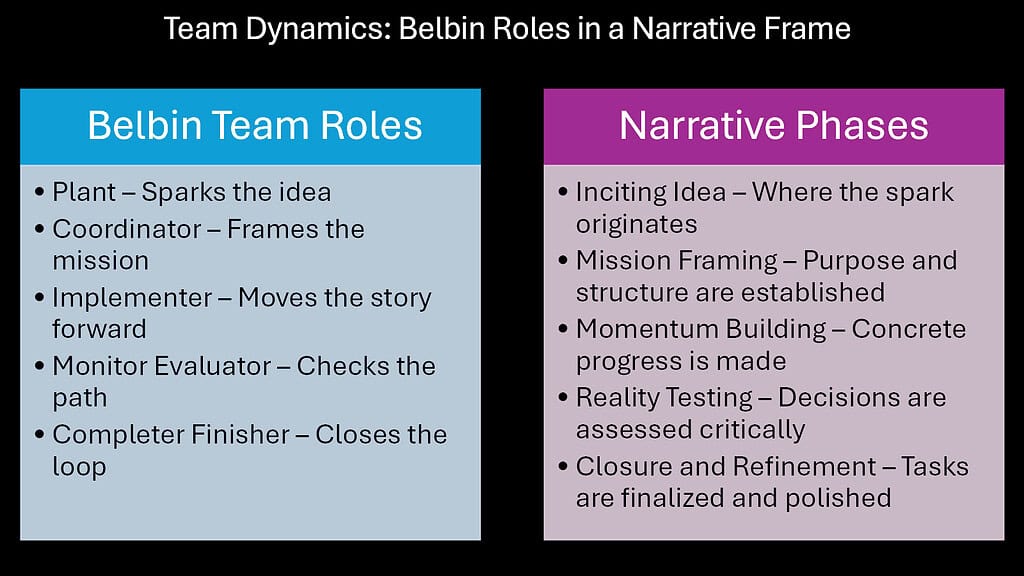
The most effective teams don’t just have complementary skills—they have complementary narrative roles that together create a complete organizational story. Meredith Belbin’s Team Roles Model offers profound insight into how team dynamics naturally distribute these narrative functions, creating what might be called a “story ecosystem” where different perspectives and contributions combine into a coherent whole.
Belbin identified nine distinct team roles, including Coordinators who facilitate, Implementers who execute, Plants who generate ideas, and Completer-Finishers who ensure quality. Research applying this model across industries shows that teams with balanced representation across these roles typically outperform those with gaps or overlaps. This performance advantage emerges partly from narrative completeness—when all essential storytelling functions are covered, the team’s collective story becomes more compelling and actionable.
“Healthy teams don’t just divide tasks efficiently—they distribute narrative responsibility,” explains Lynda Gratton, professor at London Business School. “The Monitor-Evaluator isn’t just analyzing data; they’re providing critical perspective that adds tension and realism to the team’s story. The Resource Investigator isn’t just networking; they’re bringing in external characters and subplot possibilities.”
This distribution of narratives is evident when analyzing high-performing product development teams. Research conducted by INSEAD on innovation teams revealed that those possessing balanced Belbin profiles were 2.8 times more likely to successfully launch products compared to teams with a predominance of similar roles. The diversity in narratives—incorporating both visionaries and practical thinkers, as well as relationship-oriented individuals and task-focused members—resulted in more robust stories that withstood the challenges posed by market realities.
| Belbin Role | Narrative Function | Team Dynamic Requirement |
|---|---|---|
| Coordinator | Maintains narrative coherence and direction | Needs authority supported by team dynamics |
| Shaper | Creates tension and urgency in the story | Requires team tolerance for direct challenge |
| Plant | Introduces new plot possibilities | Needs psychological safety to share unusual ideas |
| Resource Investigator | Connects to external narratives and resources | Requires team appreciation for network-building |
| Monitor-Evaluator | Provides critical perspective that tests assumptions | Needs team receptivity to constructive criticism |
| Teamworker | Maintains relationship harmony that enables story flow | Requires recognition of invisible emotional labor |
| Implementer | Translates narrative into practical action | Needs team respect for execution, not just ideation |
| Completer-Finisher | Ensures narrative quality and completion | Requires team patience with attention to detail |
| Specialist | Provides depth in specific narrative domains | Needs team integration of specialized knowledge |
This plays out dramatically in crisis situations. When Southwest Airlines faced its massive operational meltdown in December 2022, teams with balanced narrative roles could respond more effectively. Those with strong Shapers pushed for immediate action, Plants generated creative solutions to unprecedented challenges, while Monitor-Evaluators prevented overreaction—together creating a recovery narrative that acknowledged reality while maintaining hope.
Professional services firm Deloitte actively applies Belbin’s insights when forming client service teams, ensuring each project team includes complementary narrative roles. This doesn’t just improve project outcomes—it creates richer client experiences where different team members contribute distinct chapters to the engagement story.
Even in entrepreneurial settings where formal roles may be fluid, these narrative functions emerge naturally. In startup founding teams, research from Stanford’s entrepreneurship program found that ventures with balanced narrative roles secured funding at nearly twice the rate of those with lopsided distribution. Investors weren’t just evaluating business models but the completeness of the founding team’s collective story.
When team dynamics successfully distribute these narrative roles, the resulting organizational story gains both breadth and depth. Like any compelling narrative, it includes visionaries and skeptics, action-drivers and relationship-maintainers, big-picture thinkers and detail guardians. This narrative completeness doesn’t just make for better storytelling—it creates more resilient organizations equipped to navigate complexity with a shared sense of purpose and direction.
6. Team Dynamics Turn Setbacks into Storytelling Gold
Perhaps nowhere is the narrative power of team dynamics more evident than in how organizations process failure. Whether facing market rejection, operational breakdowns, or strategic missteps, teams with strong dynamics don’t just recover more quickly—they transform these moments into defining chapters in their collective story, often emerging stronger than before.
Research from the University of Michigan’s Ross School of Business studied 132 project teams across industries and found that those with healthier dynamics were 3.4 times more likely to derive strategic learning from failures. This wasn’t just about extracting lessons—it was about integrating these experiences into an ongoing narrative of resilience and adaptation.
“Great teams don’t just solve problems—they metabolize them into their identity,” notes David Cooperrider, whose Appreciative Inquiry approach has helped organizations reframe challenges across sectors. “The setback becomes part of their creation story, not something they overcome and forget.”
This narrative alchemy appears vividly in how different organizations processed public failures. When JetBlue faced a massive operational breakdown during a 2007 ice storm, stranding passengers for hours, the company’s response wasn’t merely operational. Teams with strong dynamics throughout the organization transformed this moment into a pivotal narrative about customer commitment, leading to the industry’s first Customer Bill of Rights.
| Setback Response Element | Team Dynamic Influence | Narrative Transformation |
|---|---|---|
| Initial Framing | Communication patterns shape how failure is initially described | Determines whether setback becomes tragedy or challenge |
| Responsibility Handling | Trust levels influence blame vs. learning orientation | Shapes whether characters appear as victims or agents |
| Learning Extraction | Psychological safety enables honest analysis | Creates meaning and moral from difficult experiences |
| Adaptation Visibility | Recognition practices highlight positive changes | Demonstrates character growth and evolution |
| Storytelling Practices | How often and how setbacks are referenced | Determines setback’s place in the ongoing narrative |
Japanese manufacturing culture embodies this narrative approach through practices like “hansei” (reflection) and “kaizen” (continuous improvement). Toyota’s response to quality issues in 2009-2010 demonstrates how team dynamics transformed a potential reputation disaster into a reinvigoration of the company’s core story about quality obsession.
Similarly, when IBM faced existential threat in the early 1990s, Lou Gerstner’s leadership team didn’t just execute a strategic pivot—they rewrote the company’s narrative from hardware manufacturer to solutions provider. This transformation succeeded largely because team dynamics throughout the organization enabled collective sensemaking about what IBM’s new chapter should look like.
Tech company Slack offers a more recent example. The company began as a failed gaming venture before pivoting to become a workplace communication platform. CEO Stewart Butterfield and his team didn’t hide this origin—they incorporated it into the company’s core narrative, turning potential embarrassment into a testament to adaptability that became central to Slack’s brand story.
Even literal disasters demonstrate this narrative function of team dynamics. When NASA teams processed the Columbia and Challenger and Columbia disasters, those with healthier dynamics were able to integrate these painful chapters into their ongoing story without either minimizing their impact or becoming paralyzed by them.
The key distinction isn’t whether organizations face setbacks—all do—but whether team dynamics enable these moments to become meaningful narrative elements rather than disconnected episodes. Teams with strong dynamics don’t just move past failure; they incorporate it into their collective identity, using these chapters to deepen their shared story rather than disrupt it.
Conclusion – Team Dynamics: The Narrative Engine of Long-Term Business Identity
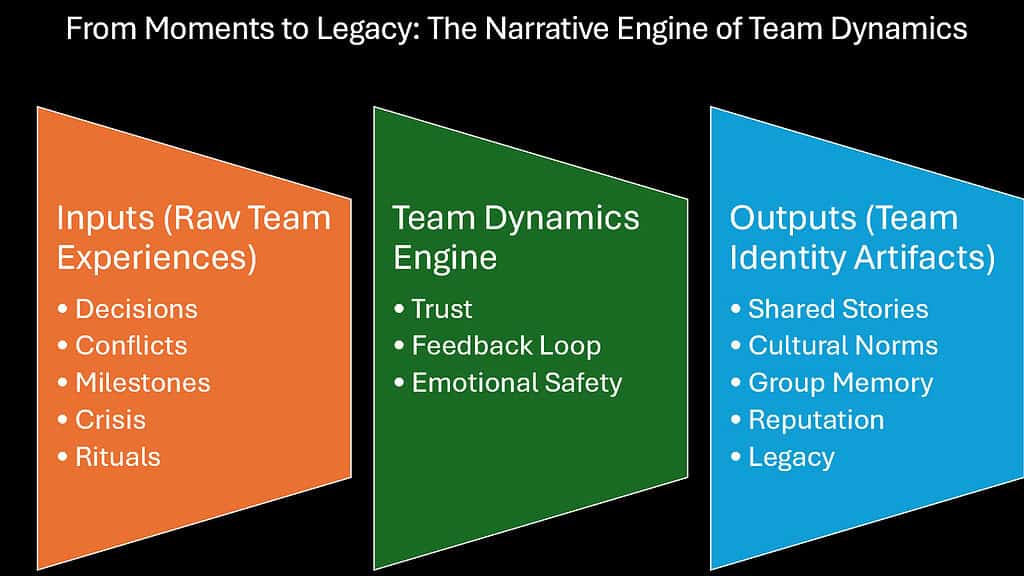
In the fast-paced world of quarterly targets and annual planning cycles, organizational memory often proves surprisingly fragile. Strategic initiatives launch with fanfare only to be forgotten when leadership changes. Market victories celebrated in one quarter become footnotes by the next. Yet amid this corporate amnesia, certain stories endure—passed between team members, surviving reorganizations, and eventually becoming part of organizational identity.
Team dynamics stand revealed as the critical force behind this institutional memory. Throughout this exploration, we’ve seen how the subtle patterns of interaction within teams quietly build narratives that outlast individual projects and even team membership itself. From sensemaking in uncertainty to transforming setbacks into defining moments, team dynamics continually weave experiences into stories that give meaning and direction to organizational life.
Research from London Business School tracking organizational narratives over time found that companies with stronger team dynamics maintained more consistent identity narratives during leadership transitions. While strategic direction might shift, the core story about “who we are” remained more stable in organizations where team-level dynamics actively maintained these narratives.
“The most enduring competitive advantage isn’t captured in strategic plans,” observes Harvard’s Teresa Amabile. “It lives in the stories teams tell themselves and others about who they are and what matters to them. These narratives become the invisible architecture supporting everything else.”
| Narrative Element | How Team Dynamics Sustain It | Long-Term Impact |
|---|---|---|
| Core Purpose | Regular reference to mission in team interactions | Maintains consistent direction despite market changes |
| Values in Action | Recognition of behaviors that exemplify core beliefs | Translates abstract values into concrete practices |
| Defining Moments | How turning points are commemorated and referenced | Creates touchstones that orient new members |
| Character Development | How individual growth is recognized and celebrated | Builds culture of continuous personal development |
| Future Vision | How possibilities are discussed and explored | Maintains forward momentum through uncertainty |
The business landscape is littered with cautionary tales of organizations that lost their narrative thread. Kodak’s well-documented struggle wasn’t merely about missing digital technology but about team dynamics that couldn’t evolve the company’s story from film manufacturer to image company. Conversely, organizations like 3M have maintained innovative identity for decades through team dynamics that continuously refresh their narrative while maintaining core themes.
In the end, team dynamics reveal themselves as far more than operational concerns affecting day-to-day productivity. They are the narrative engines that determine whether organizational experiences become meaningful stories or simply fade into corporate forgetting. They shape not just what teams do but how they remember and make meaning from those actions.
For leaders seeking to build organizations that endure beyond market cycles, this narrative function of team dynamics deserves far more attention than it typically receives. By fostering team environments where sensemaking flourishes, micro-moments get recognized, cultural elements take root, roles emerge clearly, narrative functions distribute effectively, and setbacks transform into chapters of growth, they create the conditions for lasting organizational identity.
In business, memory may fade quickly—but shared stories endure. The quiet engine driving those stories forward isn’t found in mission statements or strategic plans but in the everyday interactions of teams making meaning together. Their collective narratives ultimately become the organization’s most valuable asset—its enduring sense of who it is and why it matters.

